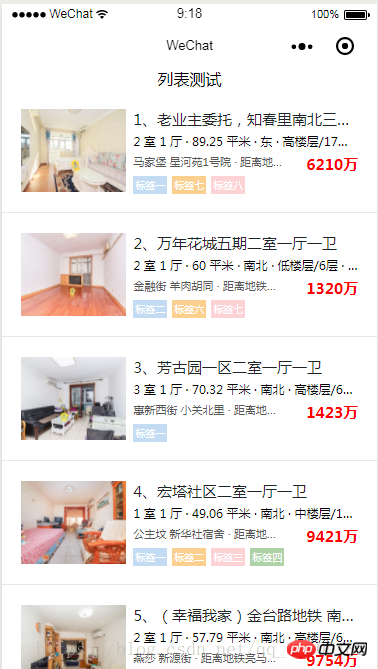
First of all, this is the original data, an array of json. This article mainly introduces the example of WeChat applet displaying json data to the applet through the API interface. The editor thinks it is quite good, so I will share it with you now and give it as a reference. Let’s follow the editor and take a look at
html part
<view class='list-head'>列表测试</view>
<view class='list-box'>
<view class='list-li mflex' wx:for="{{list_data}}" wx:key="index" >
<view class='list-img'><image src='{{item.imgUrl}}'></image></view>
<view class='list-tit'><text>{{item.id}}、{{item.title}}</text></view>
<view class='list-con'><text>单价{{item.unitprice}}元/m²</text></view>
<view class='list-adr'><text>{{item.city}}</text></view>
<view class='list-tag'>
<text class='tag_{{index}}' wx:for="{{item.tag}}" wx:for-item="cell" wx:key="index" >{{cell.tags}}</text>
</view>
</view>
</view>wx:for ="{{list_data}}" is used to loop the array, and list_data is the array name wx:for-item="cell" which is used to define a variable for each element during the loop
Remember: wx:for is a loop array, wx:for-item is to assign an alias to the list
Page({
/**
* 页面的初始数据
*/
data: { },
/**
* 生命周期函数--监听页面加载
*/
onLoad: function (options) {
var _this = this
wx.request({
url: '自己的数据地址/list.json',//json数据地址
headers: {
'Content-Type': 'application/json'
},
success: function (res) {
//console.log(res.data.imgListData)
//console.log(res.data.imgListData[0].tag)
//将获取到的json数据,存在名字叫list_data的这个数组中
_this.setData({
list_data: res.data.imgListData,
//res代表success函数的事件对,data是固定的,imgListData是上面json数据中imgListData
})
}
})
},
/**
* 生命周期函数--监听页面初次渲染完成
*/
onReady: function () { },
/**
* 生命周期函数--监听页面显示
*/
onShow: function () { },
/**
* 生命周期函数--监听页面隐藏
*/
onHide: function () { },
/**
* 生命周期函数--监听页面卸载
*/
onUnload: function () { },
/**
* 页面相关事件处理函数--监听用户下拉动作
*/
onPullDownRefresh: function () { },
/**
* 页面上拉触底事件的处理函数
*/
onReachBottom: function () { },
/**
* 用户点击右上角分享
*/
onShareAppMessage: function () { }
}){
"imgListData": [
{
"id": "1",
"title": "标题描述",
"content": "内容描述 ",
"city": "详细地址",
"adrs": "上海",
"room": "楼房描述",
"imgUrl": "图片地址",
"dataTimes": "时间",
"peo": "姓名",
"tel": "手机号",
"pho": "照片地址",
"money": "价格",
"unitprice": "单价",
"tag": [
{
"tags": "标签一"
},{
"tags": "标签七"
},{
"tags": "标签八"
}
]
},
{
"id": "2",
"title": "标题描述",
"content": "内容描述 ",
"city": "详细地址",
"adrs": "上海",
"room": "楼房描述",
"imgUrl": "图片地址",
"dataTimes": "时间",
"peo": "姓名",
"tel": "手机号",
"pho": "照片地址",
"money": "价格",
"unitprice": "单价",
"tag": [
{
"tags": "标签二"
},{
"tags": "标签六"
},{
"tags": "标签七"
}
]
}
]
}.mflex {display:flex;}
.list-head{text-align: center;font-size:32rpx;}
.list-li{height:166rpx;padding:40rpx 30rpx;border-bottom:2rpx solid #e4e7ec;flex-wrap:wrap;justify-content:space-between;flex-direction:column;align-items:center;}
.list-img{width:210rpx;height:166rpx;}
.list-img image{display: block;width:210rpx;height:166rpx;}
.list-tit,.list-adr,.list-tag,.list-con{width:calc( 100% - 240rpx );}
.list-tit{font-size:30rpx;color:#1c2627;overflow:hidden;white-space:nowrap;text-overflow:ellipsis;display:inline-block;}
.list-con{font-size:24rpx;overflow:hidden;white-space:nowrap;text-overflow:ellipsis;}
.list-adr{font-size:22rpx;color:#555;text-overflow:ellipsis;white-space:nowrap;overflow:hidden; }
.list-tag{font-size:20rpx;}
.list-tag text{background:#f5ecdf;color:#ff9d00;padding:5rpx;margin-right:10rpx;}
.list-money{font-size:30rpx;color:red;flex:1;text-align: right;font-weight:bold;}
.dizhi{flex:2;text-overflow:ellipsis;white-space:nowrap;overflow:hidden;}
.list-tag text{color:#fff;}
.list-tag .tag_0{background:#c3dbf3;}
.list-tag .tag_1{background:#fbd08f}
.list-tag .tag_2{background:#fdd2d5;}
.list-tag .tag_3{background:#add2a5;}Running results

Related articles:
WeChat applet through api Interface to display json data to mini program example
WeChat mini program Detailed explanation of for loop
Related videos:
App.json global configuration file detailed explanation-WeChat applet development video tutorial
The above is the detailed content of WeChat applet json data loop display example sharing. For more information, please follow other related articles on the PHP Chinese website!
 How to install ps filter
How to install ps filter
 How much is one Bitcoin in RMB?
How much is one Bitcoin in RMB?
 What is blockchain web3.0
What is blockchain web3.0
 What is the difference between JD International self-operated and JD self-operated
What is the difference between JD International self-operated and JD self-operated
 Words disappear after typing
Words disappear after typing
 Why can't my mobile phone make calls but not surf the Internet?
Why can't my mobile phone make calls but not surf the Internet?
 Does inflation rate have an impact on digital currencies?
Does inflation rate have an impact on digital currencies?
 How to open hosts file
How to open hosts file




